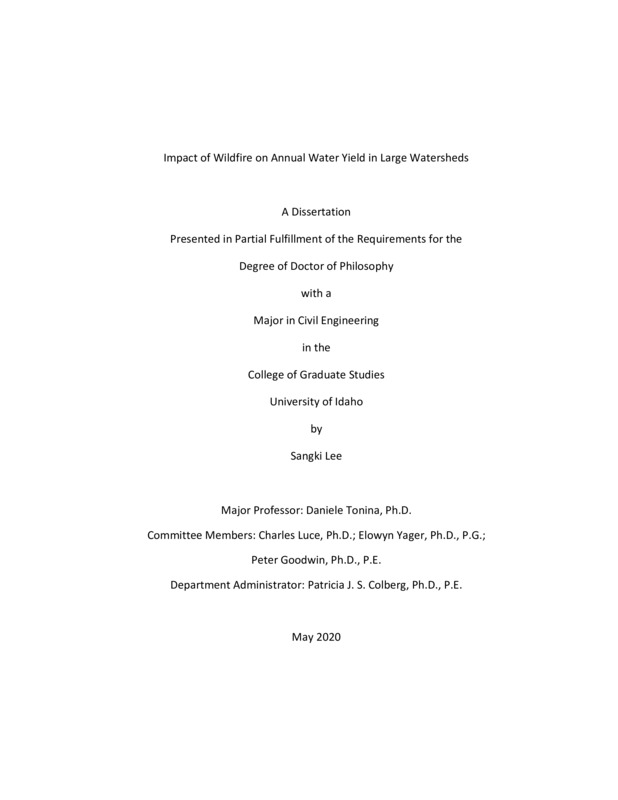Impact of Wildfire on Annual Water Yield in Large Watersheds
Lee, Sangki. (2020-05). Impact of Wildfire on Annual Water Yield in Large Watersheds. Theses and Dissertations Collection, University of Idaho Library Digital Collections. https://www.lib.uidaho.edu/digital/etd/items/lee_idaho_0089e_11451.html
- Title:
- Impact of Wildfire on Annual Water Yield in Large Watersheds
- Author:
- Lee, Sangki
- ORCID:
- 0000-0002-2535-7968
- Date:
- 2020-05
- Keywords:
- Annual Water Yield Budyko Framework Long-term Response Paired Watershed Analysis Simple Equation Wildfire
- Program:
- Civil Engineering
- Subject Category:
- Civil engineering
- Abstract:
-
Available studies on the effects of wildfire on water yield were conducted in small size watersheds (<10km2) and little is known on the scalability of those findings to large watersheds. However, the frequency and occurrence of wildfires that burn large watersheds (>100km2) have been increasing in the last decades, resulting on the need to predict their impacts on watershed hydrology. The impact of wildfire on watershed annual water yield is constrained by a complex interaction among several processes, which include hydrologic, geologic, ecologic, climatic alterations. This study investigates short- and long-term responses of annual water yield changes due to wildfire in large watersheds within a paired watershed framework. We, also, propose a new theoretical approach based on the Budyko framework to predict the change in annual water yield due to wildfires, which was originally proposed to explore alterations of water and energy balance within burned watersheds. Long-term responses of annual water yield were predicted by analyzing residuals between annual water yields measured in the field and estimated with paired watershed regression models. Paired watershed analyses were applied to 34 pairs between 11 burned watersheds and 8 unburned watersheds in the Salmon River and Payette River basin (Central Idaho USA), Yellowstone National Park (Wyoming, USA), and Klamath River basin (California, USA). The Budyko framework was conducted in 8 burned watersheds for 10 wildfires, were statistically significant from paired watershed analyses. The Budyko framework was applied both at the yearly time scale (one point for each year) and as originally developed as time averaged (one point for pre and one for post-fire period). This study employed (1) a simple linear model with evaporative index (AET/P) and (2) Fu [1981]’s equation with relative evaporative index (1-Q/P). Results show that annual water yield generally increases after wildfires that burned more than 10% of drainage area with negligible and undetectable changes for smaller burned areas. Exceptions to this trend are for watersheds whose hydrological system is dominated by baseflows (with large ground water storage) and those whose wildfire mainly burned short vegetation. Annual water yield tends to return toward pre-fire condition following the Kuczera’s curve, which is related with changes in water demand following regrowth or resuccession of burned trees/vegetation. Post-fire annual water yield increased with burned area, and this correlation was more evident in Mediterranean than in arid climate regions. Post-fire change in annual water yield increases proportionally with drainage area in small watersheds, but this relationship is limited in large watersheds. Results of the Budyko framework show decrease in evapotranspiration rate in most burned watersheds. Reduction in evapotranspiration results in an increase of annual water yield. On the other hand, increase in evaporative index was detected in burned watershed where trees grew quickly during the post-fire period. Climatic conditions can affect the hydrological response during post-fire. Weather condition is an important factor for estimating the annual water yield responses against wildfire. Budyko framework shows that wildfire impact is mitigated under wet weather condition or enhanced under dry weather condition. Results of paired watershed analysis and Budyko framework show a good agreement that post-fire annual water yield responses are strongly correlated with changes in evapotranspiration rate associated with tree mortality or regrowth rate.
- Description:
- doctoral, Ph.D., Civil Engineering -- University of Idaho - College of Graduate Studies, 2020-05
- Major Professor:
- Tonina, Daniele
- Committee:
- Luce, Charles; Yager, Elowyn; Goodwin, Peter
- Defense Date:
- 2020-05
- Identifier:
- Lee_idaho_0089E_11451
- Type:
- Text
- Format Original:
- Format:
- application/pdf
- Rights:
- In Copyright - Educational Use Permitted. For more information, please contact University of Idaho Library Special Collections and Archives Department at libspec@uidaho.edu.
- Standardized Rights:
- http://rightsstatements.org/vocab/InC-EDU/1.0/

